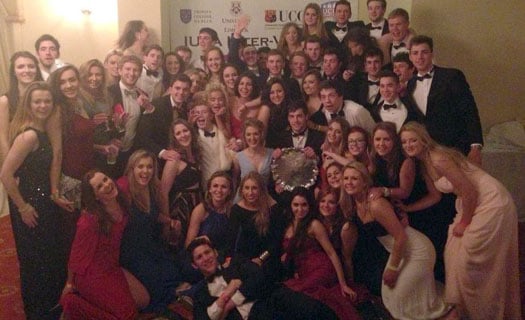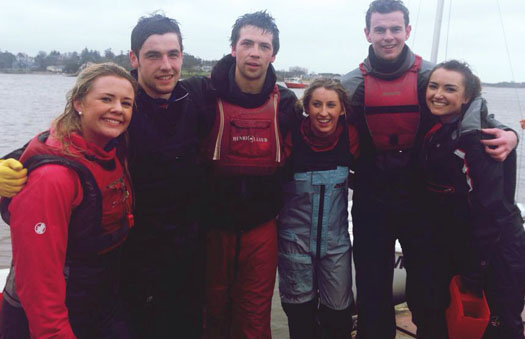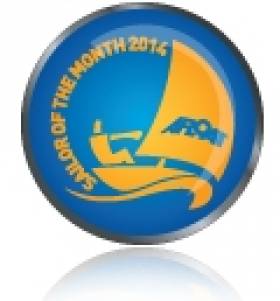Displaying items by tag: Wexford Harbour Boat Club
Fireball Hat-trick of Titles for McCartin & Kinsella
#fireball – Barry McCartin and Conor Kinsella christened their new boat, 15114, by winning the Irish Fireball Munsters at Wexford Harbour Boat and Tennis Club over this past weekend. In so doing they have now racked up their third regatta title of the season, the Ulsters and the Open Championship having gone their way as well.
Most clubs have a characteristic that makes them unique – be it a particular form of hospitality or a unique location or some interesting tradition. Wexford Harbour Boat & Tennis Club too has a unique feature and an even more unusual approach to resolving the implication of that feature! The unique feature is that they are cut off from their racing area by a bridge. Their unique approach to that feature is that depending on the state of the tide, boats are careened onto their sides with the assistance of club ribs to get under the bridge.
Sixteen Irish Fireballs made the trip to the SE corner of Ireland for the event, just over 1½hrs drive from Dublin. In addition to the christening of the newest boat in the fleet, the event saw the seasonal debut of Andy Boyle, crewed by Alexander Rumball (14934) and home debutants in the form of Ben Scallan and Ronan Wallace, sailing McCartin's previous boat (14820).
For the four Irish boats doing the Europeans this was their last session in a Fireball before they take to the roads. McCartin & Kinsella will go to the Shetlands showing good form and an ability to get out of poor situations on the course. A number of times this weekend they have been in places one wouldn't expect to see them but they always, with one exception, managed to keep biggish numbers of their score card.
The six race regatta had five race winners in McCartin & Kinsella (Races 1 & 3), Scallan & Wallace (Race 2), Boyle & Rumball (Race 4), Noel Butler & Stephen Oram (15061) (Race 5) and the Clancy Brothers, Conor and James (14807) (Race 6). Noticeable by their absences from this roll-call of race winners are Kenneth Rumball and David Moran (15058) who nevertheless put together a very consistent record of results with only one "blip".
Four races were sailed on Saturday in what were very difficult conditions. One race was shortened as it had become a soldier's course on the upwind leg but the Race Officer persevered and got four races in. Sailed in sunshine, the wind moved around constantly and saw a lot of effort going into the changing of the weather mark position and the limit mark for the start line. While the new boat won its first race, it was only late on that this looked possible as Scallan and Wallace, using local knowledge set the pace for everyone. What were to become the "usual suspects" populated the lead group, with Team Clancy, Rumball & Moran, Butler & Oram, Boyle & Rumball, Niall McGrotty & Neil Cramer (14938) and McCartin & Kinsella were at the front of the fleet as well but at the second weather mark it was Scallan and Louis Smyth & Cormac Bradley who were trying to lead the fleet around the course. Problem was that mist had enveloped the leeward mark to make matters interesting. Scallan went right on the downwind sausage, Smyth & Butler went left but Butler came back earlier and by the time the fleet got to the leeward mark, Smyth & Bradley's "fifteen minutes of fame" had elapsed. Scallan would finish fourth behind McCartin, Clancy and Butler, but he had laid down his marker.
Another Olympic course was set for Race 2, the mist lifted but the wind became a bit more fickle. The first triangle was completed with everything in order but a wind shift to the right hand side made a mockery of the second beat. Scallan leading again went to the RHS and in true "pied piper style" took a number of the lead boats with him – McGrotty & Cramer and Smyth & Bradley. The next two round, Butler & Oram and Rumball & Moran took a leftward hitch and then tacked again to sail parallel. While Scallan and McGrotty escaped the clutches of the fourth and fifth boats at the leeward mark, Smyth wasn't so lucky as both Butler and Rumball got to the finish at the second weather mark before him.
The RO then went for two windward leeward courses which made sense given that the wind had almost swung through 45˚ or more. McCartin took the first of these while the second was grabbed by Messrs Boyle and Rumball. In both races the fleet was quite compact and some new combinations were taking advantage of the more benign conditions to post good results. The stand-out result in this regard goes to Cariosa Power and Class Chairwoman Marie Barry (14854) who posted a 5,6 in the two windward leeward races. Father and son combination, Mike and James Murphy (14908) from Waterford scored a 3 in Race 3 and while one would never suggest that they needed "benign conditions" to record such a result, I'm sure they were quite happy to put such a low number on their score card.
The post-mortems in the club house afterwards were, as always, entertaining, but the best story of the night went to Glen Fisher who in the 2nd Olympic race found himself in 2nd place going round the first weather mark. Glen, crewed by Grattan Donnelly, found the experience "harrowing" particularly when he was chastised, in polite but loud terms for trying "to park the bus" halfway down the first reach.
WHBTC's BBQ was very well received by all.
Sunday morning and there were some sore heads that either manifested themselves first thing and were sorted on the water or worse still only manifested themselves on the water. The wind was now an offshore breeze and initially gave the impression that we might have some sustained trapezing. We got the trapezing but it wasn't sustained! In the first race, going left seemed to be what everyone wanted to do, especially when Scallan was seen to be going that way too. But then boats started to peel off to go right and soon it became apparent that hard left was not the place to be..........too late. Butler & Oram seemed to piece together a substantial lead that this correspondent could only admire from afar, but rounding the last weather mark it seemed that the horizon job I thought had been built was not quite what I had expected it to be. They did however hold out to win with McCartin second, to set up the most remarkable close to a regatta that I have seen for a while.
With the sixth race pending, Butler & Oram and McCartin & Kinsella were tied on 8pts after the discard was taken into consideration – it would come down to a last race decider, winner takes the spoils! Fourteen of the sixteen boat fleet became pawns on a chessboard being contested by the opposing kings. We saw these two circle each other America's Cup style, saw them sailing in the opposite direction to the start line, each trying to gain the upper-hand to shepherd their opposition into the least favoured position. It was fascinating. They entered the "mix" of the start with seconds to spare and then all hell broke loose with at least two other boats drawn into the melee. A General Recall was signalled which simply triggered an extension of the pre-race dance! Black flag starts had been the order of the regatta since the first aborted start of the first race and so the black flag came out again. At the second time of asking a general recall went up again but with the added significance of a black flag there had to be victims.........and so it proved. Butler and Oram were gone as were Neil Colin and Margaret Casey (14775). All McCartin & Kinsella had to do was keep their noses clean!
The last race of the regatta was more competitive than its predecessor which had seen the fleet strung out over two legs (and more) from 1st to last. In this race there was a much more compact bunch. But there was change at the head of the fleet. Team Murphy was up there, so was Team Clancy. Frank Miller & Ismail Inan (14713) were having their best race of the series and in addition to Power & Barry, Louise McKenna & Hermine O'Keeffe (14691) were flying the flag for the all-girl teams. At the first leeward gate, McCartin & Kinsella were back in the van, "with the plebeians". After the gate they had waltzed away from that position to be challenging the front runners who at this stage were Team Murphy, Team Clancy, Rumball & Moran and Boyle/Rumball. A range of approaches were adopted for the second beat such was the variability of the wind. Team Murphy led the fleet around the last weather mark of the regatta and held their lead to the leeward gate and into the body of the hitch to the finish. But they got caught, not once, but twice as first Team Clancy and then McCartin/Kinsella got the positions on the finish line ahead of them.
2014 Irish Fireball Munster Championships, Wexford Harbour Boat & Tennis Club, 19th & 20th July 1 2 3 4 5 6 Pts
1 Barry McCartin & Connor Kinsella 15114 RStGYC 1 6 1 4 2 2 10
2 Noel Butler & Stephen Oram 15061 NYC 3 3 2 2 1 17 11
3 Kenneth Rumball & David Moran 15058 INSC 8 4 4 3 3 4 18
4 Conor & James Clancy 14807 RStGYC 2 10 12 5 4 1 22
5 Mike & James Murphy 14908 ISA 6 8 3 9 5 3 25
6 Ben Scallan & Ronan Wallace 14820 WHBTC 4 1 7 8 9 6 26
7 Niall McGrotty & Neil Cramer 14938 Skerries 7 2 6 7 6 9 28
8 Andrew Boyle & Alexander Rumball 14934 RIYC 5 9 13 1 10 5 30
9 Cariosa Power & Marie Barry 14854 DMYC 11 13 5 6 11 8 41
10 Louis Smyth & Cormac Bradley 15007 Coal Harb. 9 5 8 11 13 11 44
11 Louise McKenna & Hermine O'Keeffe 14691 RStGYC 13 7 14 10 7 10 47
12 Frank Miller & Ismail Inan 14713 DMYC 10 14 9 13 12 7 51
13 Neil Colin & Margaret Casey 14775 DMYC 15 12 15 12 8 17 62
14 Mary Chambers & Brenda McGuire 14865 DMYC 14 11 10 15 14 13 62
15 Owen Clerkin & Hugh Johnson 14698 CYBC 12 16 11 16 15 12 66
16 Glen Fisher & Grattan Donnelly 14623 DMYC 16 15 16 14 16 14 75
Simon Doran is Sailor of the Month for March
#sailorofthemonth – Simon Doran of Courtown SC sailed his fourth intervarsities for UCD in Wexford five weekends ago, and played a key role in bringing the Dublin College in as Irish Champions for 2014. The name Doran will not disappear from the UCDSC listings, however, as his younger brother Philip was also a member of the winning team, and he will be taking over the baton of carrying the family name in intervarsity sailing in the years ahead. The next contest will be the historic Sailing Colours Match between UCD and TCD on the Liffey from the MV Cill Airne in the heart of Dublin on Saturday April 12th with the first race at 10.0am.
While we particularly honour Simon Doran for his continuing high-achieving input into student sailing, it should be acknowledged that this year's Irish Open Nationals was successfully sailed despite a period of meteorological mayhem, so it was a true team effort at all levels afloat and ashore. And thanks to sound decisions by race officers Aidan MacLaverty and Dave White, as well as the hospitality and versatile sailing water provided by Wexford Harbour Boat Club above the bridge on the Slaney Estuary, a full programme was put through for the hard-worked and well-reefed Fireflies, which continue to give sterling service as the boat of choice for team racing.
The full team which took the title for UCD were Simon Doran & Jan Dolan, Philip Doran & Bella Morehead, and Conor Murphy & Eimear McIvor. And while of course this monthly award is for the sailing achievement, we'd also like to praise all Ireland's college sailors for their spirited turnout in full black tie mode for their annual dinner in mid championship.

The Irish Varsities ball was held in Wexford as part of the IUSA Championships

The winning UCD team celebrate their Varsity title
It had a wonderfully cheering effect on the entire sailing community at a time when most of us were more concerned by wondering if our boats would be blown over in the boatyard, or if the roof would come off the house, or if not, then would the house be flooded out?





























































